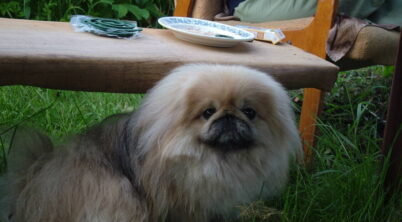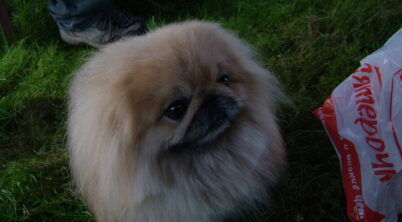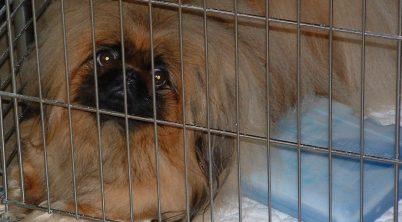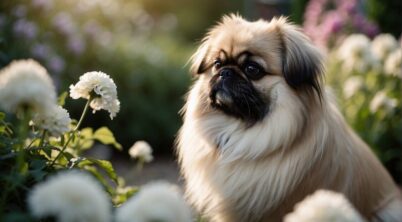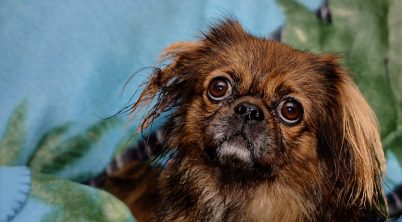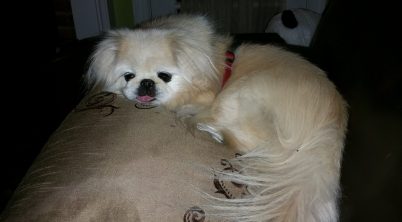The Pekingese is a breed with a storied history, originating from the ancient royal courts of China. Often referred to as ‘lion dogs’ due to their resemblance to Chinese guardian lions, these dogs were once the exclusive companions of the Chinese imperial family. This history imparts the breed with a sense of regality and dignity, characteristics that are still present in the breed’s demeanor today. Possessing a distinct personality that blends affection with a noble aloofness, Pekingese carry themselves with an air of importance that belies their small size.
Despite their royal lineage, Pekingese are adaptable to modern living conditions, but owners should be aware of their specific needs. This toy breed forms strong attachments to their humans, which can lead to separation anxiety if left alone for extended periods. The general rule of thumb is that a Pekingese can be left alone for about 4 to 6 hours, given their tendency towards needing companionship and mental stimulation. Adapting a Pekingese to alone time requires patience and a structured approach, starting with short absences and gradually increasing duration to foster independence.
Understanding the temperament and needs of the Pekingese is crucial for ensuring their well-being when they must be left alone. They are not a breed that will typically tolerate long hours of solitude without experiencing some form of stress. Thus, it is paramount that Pekingese owners consider these aspects to prevent behavioral issues and ensure a harmonious balance between their regal pet’s historical pedigree and the practicalities of contemporary pet ownership.
Table of Contents
Pekingese Left Alone
The Pekingese is a breed with a loyal and affectionate temperament toward their owners, which can sometimes lead to challenges when they are left alone. Separation anxiety is a common concern for Pekingese owners, as the breed is known to form strong bonds with their human companions. When a Pekingese is left alone, they may experience stress and engage in unwanted behaviors such as excessive barking or destructiveness.
Time Alone:
- 4-6 hours: Average time Pekingese can stay alone without severe anxiety.
- Gradual Training: Start with short periods of alone time, increasing gradually.
It is possible to manage a Pekingese’s time alone by slowly accustoming the dog to the idea of being by themselves. This should be done gradually, starting with leaving them alone for short periods and then increasing the time as they become more comfortable with the situation.
Behavioral Support Strategies:
- Provide Comfort: Leave items with the owner’s scent.
- Toys and Puzzles: Keeps them entertained and mentally stimulated.
- Regular Routines: A predictable schedule can reduce stress.
In conclusion, while the Pekingese can be left alone for limited periods, they generally do best when not left isolated for too long. Providing them with the right coping strategies and ensuring they are comfortable before gradually increasing their alone time is essential for their well-being.
Understanding the Pekingese Breed
The Pekingese is an ancient dog breed with a rich heritage rooted in China. Initially bred for the Chinese royalty, they are often associated with the luxury and exclusivity of the imperial court. Known for their lion-like appearance, the breed bears a striking resemblance to the mythical Chinese guardian lions, which is partly why they carry the affectionate nickname “lion dog.”
In terms of size, they are classified as a toy breed with a compact and stocky physique. The Pekingese’s fur is one of their most notable features, with a lush, double coat that forms a profuse mane around the neck and shoulders.
Breed Appearance
Their coat colors vary broadly, including shades of black, cream, fawn, sable, white, gray, and red. These variations contribute to the Pekingese’s regal and varied appearance, which has been admired for centuries.
Physical Features
| Feature | Description |
|---|---|
| Ears | They have heart-shaped ears that lie flat against their head. |
| Fur | The thick double coat requires regular grooming to maintain its condition. |
| Face | Pekingese have a distinctive flat face, which is a key characteristic of the breed. |
Although their appearance is charming and innocent, it is crucial not to be misled by their small stature and sweet demeanor. The Pekingese can exhibit an independent and even imperious temperament, which can be managed with early training and socialization. The breed has a loyal disposition, with a tendency to form strong bonds with their owners. This trait can lead to separation anxiety if they are left alone for extended periods, which is an important consideration for prospective Pekingese owners.
Personality and Temperament
The Pekingese breed is renowned for their distinct personality traits and a temperament that often belies their small stature. They exhibit an impressive blend of courage and self-esteem, with an independent streak that is characteristic of their heritage. Despite their size, they are not to be considered delicate; these dogs carry themselves with a regal dignity that is evident in their demeanor.
Pekingese dogs are deeply loyal to their families. This loyalty translates into a strong bond with their owners, often showing a preference for a single person whom they may shadow faithfully. This fidelity demonstrates their capacity for intense companionship.
Their temperament includes a notable affectionate side. They thrive on attention and interaction with their loved ones, being particularly sensitive to the mood and behaviors of their human companions. However, they can also display a stubborn nature, which may present challenges during training. Persistence and consistent, positive reinforcement are key in mitigating this trait.
| Traits | Description |
|---|---|
| Courageous | Brave despite their small size |
| Affectionate | Displays warmth towards their humans |
| Independent | Can enjoy time alone when necessary |
| Loyal | Forms strong bonds with family |
| Companionship | Desires closeness with their owners |
| Stubborn | May resist commands or training |
In summary, the Pekingese is a breed that carries a complex personality, being both independent and singularly devoted. Their loyalty, coupled with an inherent courage, makes them a unique companion that can enjoy time alone but ultimately seeks the love and affection of their human counterparts.
Pekingese Exercise and Training
Pekingese dogs require regular exercise to maintain a healthy weight and training to foster good behavior. Both aspects are crucial for a well-rounded and happy pet.
Exercise Needs
Pekingese dogs are small but they still need daily exercise to stay fit. While they do not require extensive physical activity, a consistent routine is essential. Owners should provide them with:
- At least one walk per day for cardio health and stimulation
- Short, playful activities that engage their minds and bodies
- Adequate attention to decrease the risk of anxiety or boredom
Long walks or excessive play can be too strenuous due to their compact build and susceptibility to overheating and breathing difficulties. Balancing rest and activity is key for their exercise needs.
Training Techniques
Training a Pekingese should begin early, focusing on positive reinforcement and patience. Key techniques include:
- Crate training, to provide a safe space and assist with housebreaking
- Teaching basic commands like sit, come, stay, and down for obedience
- Gradual steps for socializing with other dogs and people to build confidence
Pekingese may be stubborn at times; however, consistent, gentle training techniques help to establish good behaviors and mutual respect between the dog and owner. Use of treats and praises as rewards for correct behavior reinforces their training in a positive manner.
Managing Separation Anxiety
When Pekingese are left alone, they may exhibit signs of separation anxiety. This condition is characterized by symptoms such as excessive barking, destructive behavior, and signs of distress. Pet owners can manage this anxiety by incorporating several strategies into their routine to ensure their Pekingese feels comfortable and secure even when they are not around.
Symptoms Recognition
Owners should be aware of the common symptoms of separation anxiety:
- Excessive barking or howling
- Destructive chewing or digging
- Attempts to escape
- Pacing or restlessness
- Accidents despite being house trained
Gradual Conditioning
Gradually acclimatizing Pekingese to being alone can alleviate anxiety:
- Start with short departures and gradually increase the time away.
- Practice calm entry and exit cues to avoid escalating anxiety.
- Establish a safe and familiar space for the Pekingese.
Comfort Measures
Creating a comforting environment helps reduce stress:
- Leave comforting scents or articles of clothing for familiarity.
- Consistent routines can help Pekingese understand when to expect their owner’s return.
- Provide interactive toys to keep them engaged.
Behavioral Interventions
Behavioral training strategies can help manage symptoms:
- Crate training can create a haven where the dog feels secure.
- Obedience training improves the dog’s overall self-confidence.
Medical Intervention
In some cases, veterinarians may recommend medication to help manage severe anxiety. This should always be coupled with behavioral strategies.
Maintaining a calm and assured approach when dealing with a Pekingese’s separation anxiety is essential. With patience and consistent training, owners can help alleviate the stress associated with being left alone for long periods.
Feeding and Dietary Requirements
When considering the diet of a Pekingese, it’s essential to factor in their unique nutritional needs. This toy breed thrives on a balanced diet tailored to their energy levels and maintenance requirements.
Daily Feeding Guide:
- Adult Pekingese: 1/2 to 1 cup of dry food per day, divided into two meals.
- Puppies and young dogs: Follow specific puppy formula guidelines, as their growing bodies require more frequent feeding.
Key Dietary Considerations:
- Weight Management: Due to their small size and slower metabolism, Pekingese are prone to obesity. Monitor their weight regularly to adjust their diet accordingly.
- Water: Ensure they have constant access to fresh water to stay hydrated.
Food Quality: Opt for high-quality dry kibble to promote dental health as well as providing complete nutrition. Wet food can be given as an occasional treat or mixed with dry food to pique their interest.
| Mealtime Components | Details |
|---|---|
| Protein Sources | Should be high-quality and specified as the main ingredient in their food. |
| Carbohydrates | Should come from digestible sources like rice or vegetables. |
| Fats | Should be balanced, with healthy omega fatty acids for coat health. |
| Fiber | Essential for digestive health but should be in the right proportion. |
Treats: Use in moderation to avoid weight gain and should not exceed 10% of their total diet.
Maintenance Needs:
- Daily Brushing: While not related to feeding, maintaining their coat with daily brushing helps reduce the risks associated with obesity, such as overheating.
- Rest: Ensure they have a comfortable spot for downtime post meals to aid digestion.
Creating a consistent feeding schedule helps in preventing overfeeding and supports overall health. Adjust portions and ingredients based on their activity level and consult with a veterinarian for personalized advice.
Living with a Pekingese: Practical Tips
When introducing a Pekingese into a family, it’s imperative to understand its need for companionship and attention. They thrive on a consistent routine that balances affection with some degree of independence.
Exercise Needs
Due to their relatively small size and moderate energy levels, Pekingese do not need extensive exercise. However, regular short walks and playtime to maintain their weight and overall health are important.
| Activity | Frequency | Duration |
|---|---|---|
| Short Walks | Twice Daily | 15 minutes |
| Playtime | Once Daily | 20 minutes |
Companionship
Pekingese were bred for royalty and often exhibit a noble demeanor. They form strong bonds with family members and can struggle with being left alone for extended periods.
- Left Alone: 4-6 hours max
- Separation Anxiety: May manifest through barking
Behavior & Training
Consistency is key for this breed. They are intelligent but can show stubborn behavior. Training from an early age is crucial to instill good behaviors.
- Routine: Essential
- Positive Reinforcement: Recommended
Household Balance
Pekingese have a distinct body structure with a heavy front and large head, which makes them less athletic than other breeds. Families should ensure the household environment is safe and accessible to prevent injuries to their little companions.
- House Proofing: Remove obstacles
- Bed/Rest Area: Easily reachable
In summary, Pekingese make loyal companions, suited to families who can provide structure, affection, and a safe household environment. Their royal lineage dictates a need for balance between attention and respect for their independence.
Conclusion
Pekingese dogs are known for their loyalty and regal demeanor. As a breed with strong ties to companionship, their well-being is closely linked to the presence of their family. They can typically manage alone for about 4 to 6 hours. Beyond this, they may experience discomfort, which can lead to health issues such as separation anxiety.
Routine
Maintaining a consistent routine is essential. Pekingese thrive on predictability, which contributes to their sense of security.
Health Maintenance
Their health is paramount to ensure an optimal quality of life and a longer life span. To support their health:
- Provide regular exercise, but monitor for overexertion due to their small size.
- Keep up with veterinary check-ups and preventative care.
Comfort Measures
When they must be left alone, comfort measures can help:
- Leave familiar items, such as toys or bedding, to provide a sense of security.
- Consider a pet sitter or doggy daycare for extended absences.
Family Interaction
Quality interaction with their human family is critical. Frequent, loving contact nurtures their loyal nature and positively impacts their overall quality of life.
Incorporating these practices will aid in sustaining the majestic yet sensitive Pekingese’s well-being, ensuring they lead a fulfilled and healthy life even when periods of solitude are necessary.

